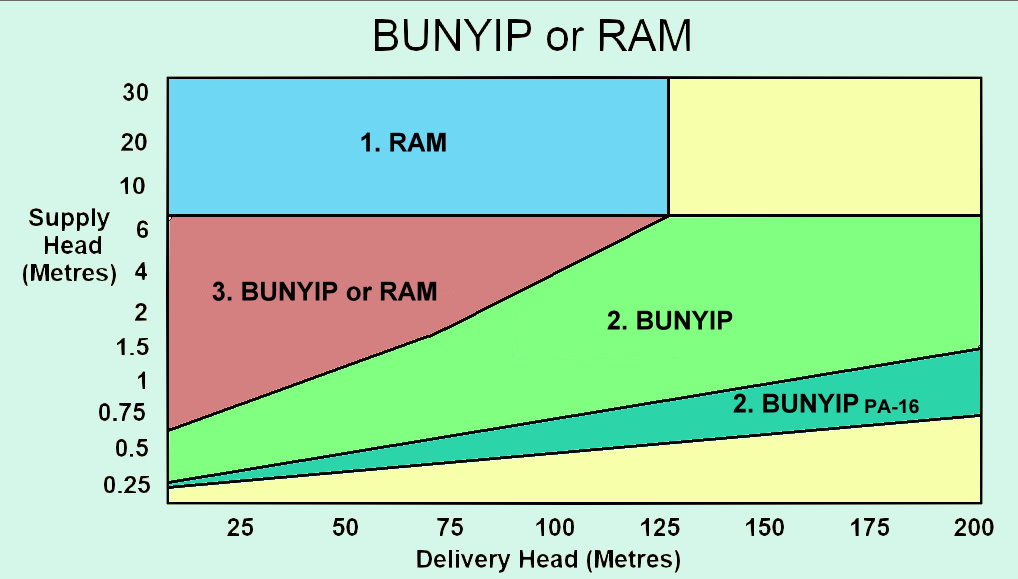HISTORY OF WATER-POWERED PUMPING:
BUNYIP IS NOT A RAM PUMP!
When it comes to water-powered pumping for near three hundred years, there has been a very effective device that is simple & efficient that most people know about: THE HYDRAULIC RAM.
BUT one problem; low supply heads are out of their range.
Over the years, many devices have tried to utilise the energy of falling water in these ‘low supply head’ sites, but all have had limitations or compromises.
UNTIL NOW!
There is every reason to believe the BUNYIP will be the long-term solution to this challenge.

The above graph shows what type of sites are applicable for the BUNYIP & RAM pumps.
Note: This graph is approximate & partly based on a presently available high-quality RAM.
Three zones:
- Above 6m falls for RAM pumps.
- Below 6m falls for BUNYIP pumps.
- Both BUNYIP & RAM pumps could work.
The problem for RAMs in zone 3 concerns their ability to handle large volumes of water flow.
For low-fall sites to have outputs comparable to high-fall sites, larger volumes of input water flow or supply rate are required, which is where the BUNYIP excels.
The only way a RAM can be considered or compete is either a ½ tonne monster RAM or the use of multiple small rams in each case impractical.
COMPARING THE BUNYIP TO THE RAM:
- The RAM needs a minimum supply head in the 2m to 3m compared to the Bunyip’s minimum supply head as low as 1 foot / 300mm.
- The RAM doesn't self-regulate, i.e., if the input flow drops too low, it needs to be adjusted & restarted. Where the BUNYIP will cycle slower or intermittently to the point of stopping/stalling & waiting for the flow to resume, this feature of the Bunyip is simply imperative to cater for fluctuating stream flows that can also be caused by a neighbour pumping upstream.
- The BUNYIP can also self-regulate, in most cases, via a float valve in your storage tank, meaning it only pumps when you need water.
- The Bunyip doesn't need an air chamber to cushion its output due to its smooth, efficient, non-water hammer action.
- The Bunyip PA-13 efficiently utilizes up to 8 Litre per second of input water flow (supply rate), whereas a RAM would need to be massive (or many small ones), requiring a crane to install.
6” RAM will weigh over ½ a Tonne & will cost a lot.
Due to the Bunyip’s constant input flow compared to the RAM's stop-start action means:- It can use smaller diameter supply pipes.
- Needs no "supply tank“;
- The Bunyip’s many advantages come from the fact that the Bunyip does not use the water hammer principle. The RAM's water hammer principle requires a limited window of drive pipe dimensions; diameter, length, flow rate & slope, unlike the BUNYIP that does not need a "Drive pipe.“ The Bunyip only needs a "supply or feed pipe," which has far fewer limitations. So as long as some water goes down a pipe, small diameter or big (no ‘complex’ dynamics), the pump will operate.
- The Bunyip can use lightweight supply pipes with elbows, typically PVC stormwater or ‘down’ pipe (can use screws instead of PVC cement); even bamboo could do the job…..).
- The BUNYIP is relatively quiet.
- The BUNYIP can be powered by dirty water & pump clean water from a different source.
- Conclusion: The BUNYIP is truly revolutionary!
